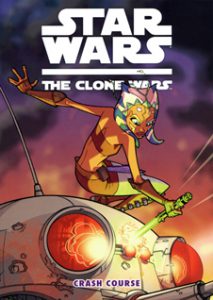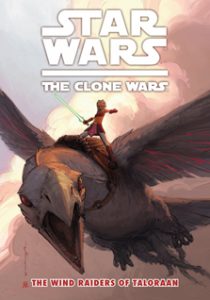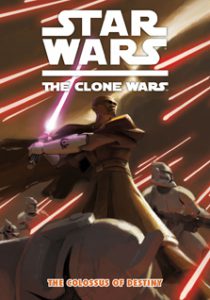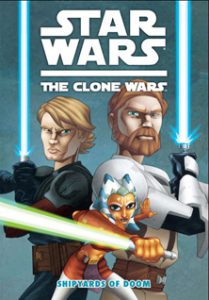Although “The Clone Wars” did try some adult tie-ins, such as the 12-issue comic series and a few novels, it mostly aimed for younger audiences. This is particularly evidenced by the 11 “Clone Wars” digests, sometimes called “graphic novellas.” However, these digests are not as kid-oriented as the “Clone Wars Adventures” digests from earlier in the decade, and today – given the TV series’ premature cancellation – they stand as a way to soak up a bit more “Clone Wars,” and from some pretty good writers, to boot.
Granted, they do tend toward the standard plot of the Republic and Separatists clashing over a valuable resource on a random planet, with the unfortunate inhabitants caught in the middle. There’s often a line or two from a Jedi about how war is terrible, but they must endure, or from a clone about how war is the only thing they know, so they aim to be good at it. Still, there’s something comforting about the ole Obi-Wan/Anakin/Ahsoka banter, and sometimes there’s a bit more depth to be gleaned.
Here’s a closer look at the first four entries:
First up is Henry Gilroy’s “Shipyards of Doom” (September 2008), an early example of George Lucas’ and Dave Filoni’s treatment of the EU as concept materials to be mined (something that unfortunately is now S.O.P. with Disney in its creation of “new” stories, which is why – for old-school fans — there’s little sense of surprise or delight in their “Star Wars” work). The Jedi and clones carbon-freeze themselves in order to get past life-form scanners to a Sep factory on Gwori. This exact same plot point was used in Season 3’s “The Citadel” in 2011, and with Ahsoka sneaking onto that mission too, there can be no doubt it was lifted wholesale from “Shipyards of Doom.”
The digests’ writers saw their work as part of the grand saga, though, as witnessed by Gilroy’s reference to Saesee Tiin’s precise hyperspace jump in the “Republic” comics where he gets between a blockade and the target planet. Electroshock racks call to mind Lucas’ early “A New Hope” draft (adapted to comics as “The Star Wars”) where the Imperials torture suspected rebels out in the open, and we see a Republic bomber that’s part of a line that will eventually become Y-wings.

“Crash Course” (December 2008), written by Gilroy and Gary Scheppke, is the best of this batch. It uses the “important data file” maguffin, which of course goes back to “A New Hope,” but tacks on lots of fun and humor as Anakin volunteers Ahsoka for a podrace on Mon Gazza. The miffed Padawan refers to Anakin as her “oil boy” (sorry, I couldn’t help but think of “Dumb and Dumber”), and they clash over whether a Twi’lek racer – whom Ahsoka is investigating perhaps too intimately (making this her only romance yarn outside of Lux from the TV series) – is the Separatist agent. Mon Gazza’s podrace course, including tubes that may or may not have an exit, is a great parody of the dangerous course in “The Phantom Menace.” And in a nice touch, Ben Quadinaros (misspelled “Quadrinaros” here) wins the race!


I had high hopes for “The Wind Raiders of Taloraan” (May 2009) because it’s written by John Ostrander, one of the elite “Star Wars” comic writers. Taloraan is so similar to Bespin – including its tibanna gas mines and the titular flying creatures and mounts that smack of other EU works about the planet — that one wonders why the story doesn’t simply use Bespin. But Ahsoka has her moments, standing up to a Wind Raider who claims he owns her, and Ostrander includes the occasional darker element, such as a corrupt official committing suicide by walking off the edge of the floating city.

Jeremy Barlow’s “The Colossus of Destiny” (December 2009) has its value as a Mace Windu yarn. We see in sketchy flashbacks that Mace had helped Simocadia fight off invaders in the past, so he takes it upon himself to be a one-man wrecking crew to save the planet from the Separatists. Barlow illustrates how Windu’s calm demeanor in the Jedi Council chambers belies an inner rage, which – as readers of the novel “Shatterpoint” know — is attributable to the fact that he’s from Haruun Kal, and like all natives of that planet has a bit of the dark side in him. The events of “Colossus” leave him as hollow and bitter as ever, making this a worthy entry for fans who want to gather up materials about this too-enigmatic character.
Art for each of these four books is by the workmanlike Fillbach Brothers, mainstays on “Clone Wars Adventures.” It gets the job done – and Ronda Pattison’s color palette effectively mimics the TV show — but it works better on romps such as “Crash Course” more so than would-be grimmer stuff like “Colossus.”
“Republic” – or even “The Clone Wars” comic series — this ain’t, but these digests (some of which I am reading for the first time) aren’t as shallow as I feared. But I hope they’ll branch into a wider variety of tales as the series moves forward.

